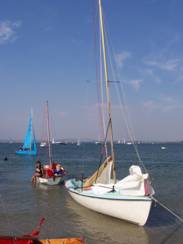



|
Mandiri Training Foundation |
|
Realising Potential and Promoting Independence |

|
The Boat
|
|
The Wildfire is an Ian Proctor designed open keelboat. At 16'9" loa, lines are reminiscent of other Proctor designs like the Kestrel and the Tempest.
The design's main identifying feature is its low -tech lifting keel arrangement. The keel is essentially a hollow daggerboard secured in place by a hatch. Ballast is lowered into the keel by the crew in small bags of lead shot effectively filling the keel and providing all the stability the boat needs and the ability to self-right after a capsize. The low-tech nature of this arrangement means that no additional equipment like winches need to be fitted to raise the keel and, indeed the keel can be raised at any time at a moment's notice. The bags are relatively light-weight and can easily be manhandled in the boat, even by children and being soft do not cause any damage. Disadvantages are that the daggerboard is still not as quick and convenient to operate as a conventional centreboard arrangement but, I feel that having the ballast there more than makes up for this inconvenience.
Brandane II belongs to my father who has owned her for nearly thirty years. Built in 1969 by Ashford Marine she is beginning to show her years, but still seems to have all the strength and robustness that one should expect from a cruising boat.
In recent years we have made some modifications, as much in the interests of economy as for improving performance. The most obvious of these is the choice of sails. The original Dacron sails we had were finally degenerating to the point where they could no longer be relied upon and were replaced with a second-hand set of ISO sails. For those who don't know the ISO, it is a fully battened, trapezing asymmetric racing dinghy as unlike the wildfire as it is possible to get! However, the sails fitted the Proctor rig perfectly and have given us the power benefits of a fully battened Mylar main. One set of reefing points were added to the main. Recent experience has told us that a second set wouldn't come amiss. Light to medium wind performance offwind is enhanced by the addition of a new-style super-sized 505 spinnaker. This is a conventional symmetrical set up an has proved itself to be a real bonus.
We have noticed a couple of disadvantages with the fully battened rig that will be familiar to all who use such rigs regularly. Firstly, although the rig does not flog and make such a racket as a conventional rig when rigging or hove to, it's tendency for the battens to pop full first on one side and then the other can be disconcerting. That said, you can still at least hear yourself think as there is little noise. Secondly, fully battened sails are difficult to get up the mast. We are still working on this, but a 2:1 main halyard, silicone spray and some technique changes have made this difficulty at least bearable.
On the whole, we have here a fast, safe and relatively stable cruising boat that does nearly all the things that a dinghy can but that also has many of the benefits of a conventional cruising yacht. Its speed is such that it can keep up in most conditions with many 30 + footers and what is most pleasing, it cost an awful lot less than most dinghies!
Anyone interested in these boats for whatever reason, please feel free to contact us.
Brian Whitmey |


|
The Wildfire |